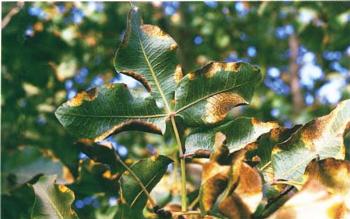Alternaria Late Blight

The first symptoms of Alternaria late blight appear in late July/August when high humidity in pistachio orchards favors the formation of dew. The main damage to pistachios by the disease is the staining of the nut shell with occasional also mold on the kernels and the early defoliation of trees. Excessive defoliation upon shaking the trees at harvest may slow down the harvest and post-harvest operations. Some growers estimate a $1,000 loss per acre due to shell staining and lower nut quality resulted from Alternaria infections. Although the disease occurs annually in California, the severity varies from between years and across locations depending mainly on micro-environmental conditions. Furthermore, as orchards age and canopies expand to adjacent trees, this creates favorable conditions for the disease. Therefore, Alternaria late blight has been observed in more and more orchards causing epidemics.

